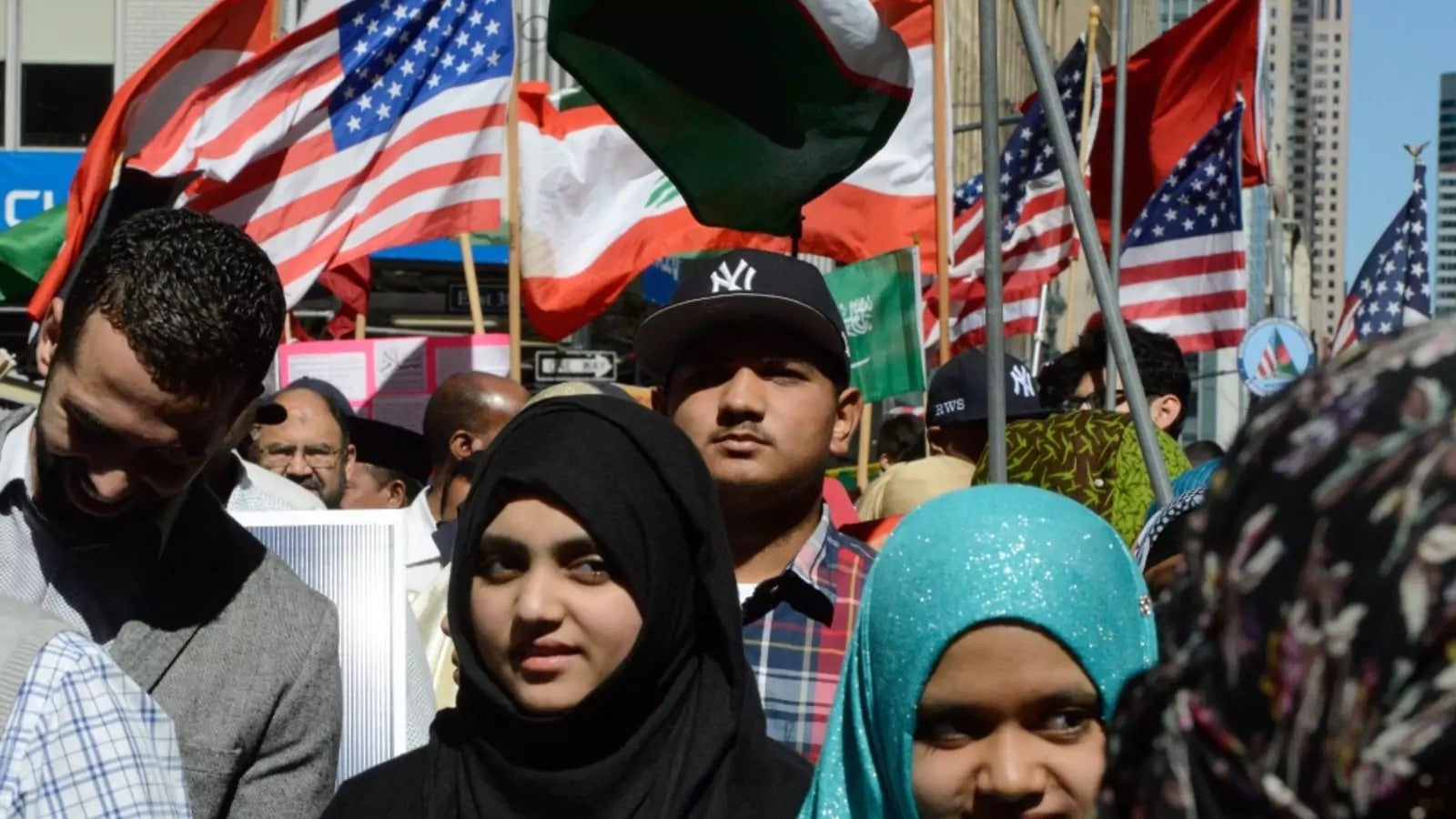
(Image Credit: Stephanie Keith/Reuters)
Report: Islamophobia Lower Among US Latinos
The Latino communities across the United States continue to grow as a sizable portion of the public, currently comprising nearly one-fifth of the total population. In 2023, the U.S. Census estimated that over 63.7 million people originate from Latino backgrounds and a 2019 study found that nearly one-in-ten Muslims in America are Latino (9%) as well.
To understand how Latino people across America view Islam and Muslims, the Institute for Social Policy and Understanding (ISPU) published an October 2023 report, which found that Latinos generally have lower levels of Islamophobia than other racial and ethnic groups in America today. The report found that Latinos exhibited lower levels of Islamophobia when they perceived themselves as having “similar life experiences” (as fellow immigrants chasing the “American Dream”) and/or if they have ever had personal interactions with American Muslims.
Since both minority communities (Latinos and Muslims) have been victims of political demonization, racial discrimination, hate crimes, and negative media portrayals, this October 2023 ISPU study found that Muslims were generally viewed more positively in these areas because Latinos were able to empathize with their shared experience as scapegoated minority communities in America.
The primary findings of the report centered around shared minority experiences between Latinos and Muslims revolving around racial discrimination and the immigrant experience in pursuit of the American Dream. “We all feel discrimination. Latinos, Muslims, we face discrimination in some type of way,” said a 30-year-old female Latina respondent. “For example, women as a whole. You know whether we are Muslim, Catholic, Christian…we’re all oppressed in a way.” Another 49-year-old male respondent stated in response to a word association exercise, “[When] I think about [the word] Muslim…I just think of another brown person. I’m like, oh, that’s another person who’s brown like me… that’s my association.” He continued to state that both Latinos and Muslims are “both treated like we’re the underdogs. So we have similarities in the way we’re seen and treated. So yeah, we can work together.”
When discussing the overall immigrant experience in America, the researchers interestingly found that very few Latino respondents mentioned right-wing political rhetoric around undocumented immigrants and/or attempts to ban Muslims from traveling into the United States. Instead, the respondents found commonality with Muslims based on shared cultural and social factors (rather than political ones) revolving around the quest for “American Dream”. When asked about similarities between Latinos and Muslims, a 24-year-old Latino male said, “First of all, we’re both Americans. [The thing about] being an American is that it’s not really a race or a specific religion. It’s just a bunch of group[s] of people who loosely believe in the same kind of system, like democracy, freedom, individual liberty, and all that.”
Another 45-year-old female focus group participant echoed similar sentiments shared by many minority communities who seek the American Dream. “They want to have, you know, their own American dream as well be a homeowner & be well set financially.” She further noted that both Muslims and Latinos regularly communicate with their families back home and have strong ties to their country of origin, so she felt like they were not very different at all.
In 1954, Dr. Gordon Allport (one of the founding figures of personality psychology) coined the phrase “contact hypothesis,” which is a psychological theory that suggests that direct contact between members of different social and/or cultural groups can help reduce prejudice, improve intergroup relations, and promote mutual understanding. This concept of “humanization” suggests that prejudice and conflict between different demographic groups can be reduced if members of the groups interact with each other personally.
The 2023 ISPU report on Latino attitudes towards Muslims supports Allport’s “contact hypothesis” theory since personal interactions with Muslim friends, neighbors, and/or co-workers led many Latino respondents to generally express positive views of American Muslims overall.
According to the ISPU researchers, the “religiosity” of Latino respondents also played a role (both positively and negatively) in their views of Muslims, depending on the schematic framework. Some Latino respondents who identified as “religious” viewed their shared religiosity with Muslims as a positive force, while others who were more dogmatically Christian viewed it as a negative point of difference with Muslims because of perceived theological differences.
A 33-year-old female respondent said that she admired Muslims because they are people “who are faithful” to their beliefs and “seek at all costs” to assert their religious freedom rights in America. To illustrate her point, she talked about getting her passport photo taken and how she noticed that Muslim women in hijab actively fought for their legal right to take passport photos with their headscarves which she says makes them “admirable people” in her eyes.
However, this same notion of “religiosity” also cuts both ways and it was also seen as a negative driver in the growth of Islamophobia as well because of perceived misogyny, stereotypes of Muslims as terrorists, and religious dogma as points of difference between some observant Christian Latinos as well.
Although there seems to be lower levels of Islamophobia generally amongst Latinos, one of the major reasons why Islamophobia still does persist within these communities is because of the “perceived misogyny” of Muslims; including perceptions of patriarchy within Islam, perceptions that women lack autonomy, and comparisons to anachronistic ‘machismo’ culture,” which are found in some Latino cultures as well.
A 2022 ISPU study called “American Muslim Poll 2022: A Politics and Pandemic Status Report” found that “perceived misogyny” in Muslim cultures was a central theme for the persistence of Islamophobia within the general public. It revealed that the most common themes of Islamophobia observed amongst Latinos revolved around the perceived mistreatment of Muslim women across the globe. “I think [Muslim men] treat [Muslim women] as inferior beings,” according to a 62-year-old Latina female. “Completely like if they were things, objects. The woman is a possession for them,” she stated.
Another similar theme on Latino Islamophobia focused on the perception of Islam as a patriarchal religion, especially when respondents were asked about Muslim women choosing to wear the hijab. These themes around perceived Muslim patriarchy were also evident after participants were asked if they would be concerned if someone close to them (especially a woman) was planning to convert to Islam.
Finally, like many other minority groups, this study found that Latinos had lower levels of Islamophobia mainly because Latinos “do not have crystallized or deeply entrenched views about American Muslims” yet, primarily because of limited interactions with them. The study found that creating video educational materials (both in Spanish and English) were effective methods of shifting Latinos attitudes in positive directions towards Islam and Muslims (especially video testimonies with Muslim women explaining why they choose to wear a hijab were seen as particularly persuasive to Latino audiences).
Since most immigrant and minority groups across the United States chase the “American Dream” while maintaining the importance of family, hard work and devotion to faith, the October 2023 ISPU study on Islamophobia amongst Latinos suggested that future research should probe how aspirations for the American dream and the immigrant experience in the United States lead to lower levels of Islamophobia among other minority groups as well. For this reason, they suggested that future studies should focus on Islamophobia in other minority groups- like studying Asian-Americans- since they are the fastest growing immigrant group in the United States at the moment. This would allow researchers to see the commonalities and differences in how Islamophobia manifests within different minority communities who are all pursuing the “American Dream” and call the United States their home today.

 Search
Search